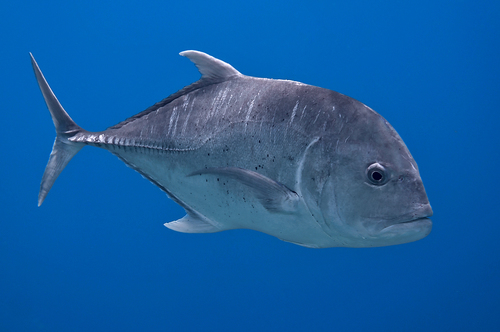
Giant Trevally
The Atlantic bluefin tuna (Thunnus thynnus) is a highly migratory, large pelagic fish renowned for its size, speed, and commercial value. This apex predator plays a crucial role in the marine ecosystem and has been a prized catch for centuries, leading to significant conservation concerns.
10 25 years
Lifespan
170 cm
Length
Least Concern
Conservation Status
43 km/h
Swimming speed
Carnivorous
Diet
Local Migration
Migration
Appearance Overview
The Atlantic bluefin tuna is a large, streamlined fish with a metallic blue body and a silvery underside.
Coloration
Dark metallic blue on top with a silvery underside
Body shape
Torpedo-shaped, built for speed and endurance
Fins
Two dorsal fins, the first depressible; small, yellow finlets running from the second dorsal and anal fins to the tail
Length
Up to 13 feet (4 meters)
Weight
Up to 2,000 lbs (907 kg)
Diet
Carnivorous, feeding on a variety of fish, squid, crustaceans, and eels.
Feeding Behavior
Highly active predator that uses its speed and agility to hunt. They often hunt cooperatively, herding and trapping prey.
Social Behavior
Forms large schools, especially during migration. They are highly migratory, capable of crossing entire oceans.
Commercial Relevance
Extremely high value, particularly in the sushi and sashimi markets. It is one of the most expensive fish species globally.
Conservation measures
International fishing quotas, size limits, and seasonal closures. Monitoring programs and efforts to reduce bycatch are also in place.
Status
Endangered (Varies by population segment; some are considered critically endangered)
Threats
Overfishing (historically and continues to be a major threat), illegal fishing, and bycatch in other fisheries.
Habitat Distribution
Depth Range
0-1,000 meters (0-3,280 feet), but typically found in shallower waters.
Geographic Range
Western and Eastern Atlantic Ocean, Mediterranean Sea. Historically also found in the Black Sea.
Preferred Environment
Pelagic, open ocean environments; prefers temperate waters.
Reproduction and Life Cycle
Breeding Habits
Spawns in warm waters, primarily in the Mediterranean Sea and the Gulf of Mexico. Spawning occurs in large aggregations.
Development Stages
Eggs are pelagic and hatch into larvae. Larvae are planktonic and undergo rapid growth, developing into juveniles and eventually adults.
Fecundity
Females can produce a large number of eggs, up to 30 million eggs per spawning season, depending on their size.
Maturity Age
Reaches sexual maturity at around 4-8 years in the Mediterranean and 8-12 years in the western Atlantic.
Faqs about Giant Trevally
Where can I find Atlantic bluefin tuna?
Atlantic bluefin tuna are found in the western and eastern Atlantic Ocean, and the Mediterranean Sea.
How fast can Atlantic bluefin tuna swim?
They are among the fastest fish in the ocean, capable of bursts of speed up to 43 mph (70 km/h).
How long do Atlantic bluefin tuna live?
Atlantic bluefin tuna can live up to 40 years.
Are Atlantic bluefin tuna warm-blooded?
Yes, they are warm-blooded, which allows them to maintain a higher body temperature than the surrounding water, aiding in muscle efficiency.
Do Atlantic bluefin tuna migrate?
They migrate long distances for feeding and spawning, sometimes crossing the entire Atlantic Ocean.
What do Atlantic Bluefin Tuna eat?
They primarily eat fish, squid, crustaceans, and eels.
How expensive is Bluefin Tuna?
The price varies greatly depending on quality, size, and market demand, but it can be hundreds or even thousands of dollars per pound.
Why are Bluefin Tuna endangered?
Overfishing has severely depleted their populations, making them endangered.
Copyright @ Nature Style Limited. All Rights Reserved.
 English
English